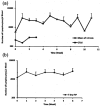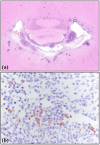Efficacy of a 3C-like protease inhibitor in treating various forms of acquired feline infectious peritonitis
- PMID: 28901812
- PMCID: PMC5871025
- DOI: 10.1177/1098612X17729626
Efficacy of a 3C-like protease inhibitor in treating various forms of acquired feline infectious peritonitis
Abstract
Objectives The safety and efficacy of the 3C-like protease inhibitor GC376 was tested on a cohort of client-owned cats with various forms of feline infectious peritonitis (FIP). Methods Twenty cats from 3.3-82 months of age (mean 10.4 months) with various forms of FIP were accepted into a field trial. Fourteen cats presented with wet or dry-to-wet FIP and six cats presented with dry FIP. GC376 was administered subcutaneously every 12 h at a dose of 15 mg/kg. Cats with neurologic signs were excluded from the study. Results Nineteen of 20 cats treated with GC376 regained outward health within 2 weeks of initial treatment. However, disease signs recurred 1-7 weeks after primary treatment and relapses and new cases were ultimately treated for a minimum of 12 weeks. Relapses no longer responsive to treatment occurred in 13 of these 19 cats within 1-7 weeks of initial or repeat treatment(s). Severe neurologic disease occurred in 8/13 cats that failed treatment and five cats had recurrences of abdominal lesions. At the time of writing, seven cats were in disease remission. Five kittens aged 3.3-4.4 months with wet FIP were treated for 12 weeks and have been in disease remission after stopping treatment and at the time of writing for 5-14 months (mean 11.2 months). A sixth kitten was in remission for 10 weeks after 12 weeks of treatment, relapsed and is responding to a second round of GC376. The seventh was a 6.8-year-old cat with only mesenteric lymph node involvement that went into remission after three relapses that required progressively longer repeat treatments over a 10 month period. Side effects of treatment included transient stinging upon injection and occasional foci of subcutaneous fibrosis and hair loss. There was retarded development and abnormal eruption of permanent teeth in cats treated before 16-18 weeks of age. Conclusions and relevance GC376 showed promise in treating cats with certain presentations of FIP and has opened the door to targeted antiviral drug therapy.
Conflict of interest statement
YK, KOC and WCG have patent claims on the protease inhibitors in the manuscript. The other authors declare no potential conflicts of interest with respect to the research, authorship, and/or publication of this article.
Figures












Comment in
-
Response to Dr Pedersen's article.J Feline Med Surg. 2018 Apr;20(4):402. doi: 10.1177/1098612X17751016. Epub 2018 Jan 11. J Feline Med Surg. 2018. PMID: 29323606 Free PMC article. No abstract available.
Similar articles
-
Reversal of the Progression of Fatal Coronavirus Infection in Cats by a Broad-Spectrum Coronavirus Protease Inhibitor.PLoS Pathog. 2016 Mar 30;12(3):e1005531. doi: 10.1371/journal.ppat.1005531. eCollection 2016 Mar. PLoS Pathog. 2016. PMID: 27027316 Free PMC article.
-
Effect of GS-441524 in combination with the 3C-like protease inhibitor GC376 on the treatment of naturally transmitted feline infectious peritonitis.Front Vet Sci. 2022 Oct 28;9:1002488. doi: 10.3389/fvets.2022.1002488. eCollection 2022. Front Vet Sci. 2022. PMID: 36387398 Free PMC article.
-
Serologic, Virologic and Pathologic Features of Cats with Naturally Occurring Feline Infectious Peritonitis Enrolled in Antiviral Clinical Trials.Viruses. 2024 Mar 17;16(3):462. doi: 10.3390/v16030462. Viruses. 2024. PMID: 38543827 Free PMC article.
-
Current status on treatment options for feline infectious peritonitis and SARS-CoV-2 positive cats.Vet Q. 2020 Dec;40(1):322-330. doi: 10.1080/01652176.2020.1845917. Vet Q. 2020. PMID: 33138721 Free PMC article. Review.
-
[Options for treatment of feline infectious peritonitis - previously and today].Tierarztl Prax Ausg K Kleintiere Heimtiere. 2023 Oct;51(5):351-360.. doi: 10.1055/a-2147-3999. Epub 2023 Nov 13. Tierarztl Prax Ausg K Kleintiere Heimtiere. 2023. PMID: 37956666 Review. German.
Cited by
-
Development of a GC-376 Based Peptidomimetic PROTAC as a Degrader of 3-Chymotrypsin-like Protease of SARS-CoV-2.ACS Med Chem Lett. 2024 Jan 10;15(2):250-257. doi: 10.1021/acsmedchemlett.3c00498. eCollection 2024 Feb 8. ACS Med Chem Lett. 2024. PMID: 38352832
-
Potent 3CLpro inhibitors effective against SARS-CoV-2 and MERS-CoV in animal models by therapeutic treatment.mBio. 2024 Feb 14;15(2):e0287823. doi: 10.1128/mbio.02878-23. Epub 2023 Dec 21. mBio. 2024. PMID: 38126789 Free PMC article.
-
Development of optimized drug-like small molecule inhibitors of the SARS-CoV-2 3CL protease for treatment of COVID-19.Nat Commun. 2022 Apr 7;13(1):1891. doi: 10.1038/s41467-022-29413-2. Nat Commun. 2022. PMID: 35393402 Free PMC article.
-
Clinical and Molecular Relationships between COVID-19 and Feline Infectious Peritonitis (FIP).Viruses. 2022 Feb 26;14(3):481. doi: 10.3390/v14030481. Viruses. 2022. PMID: 35336888 Free PMC article. Review.
-
Mannose-Binding Lectins as Potent Antivirals against SARS-CoV-2.Viruses. 2023 Sep 6;15(9):1886. doi: 10.3390/v15091886. Viruses. 2023. PMID: 37766292 Free PMC article.
References
-
- Carter W, Connelly S, Struble K. Reinventing HCV treatment: past and future perspectives. J Clin Pharmacol 2017; 57: 287–296. - PubMed
Publication types
MeSH terms
Substances
Grants and funding
LinkOut - more resources
Full Text Sources
Other Literature Sources
Miscellaneous

